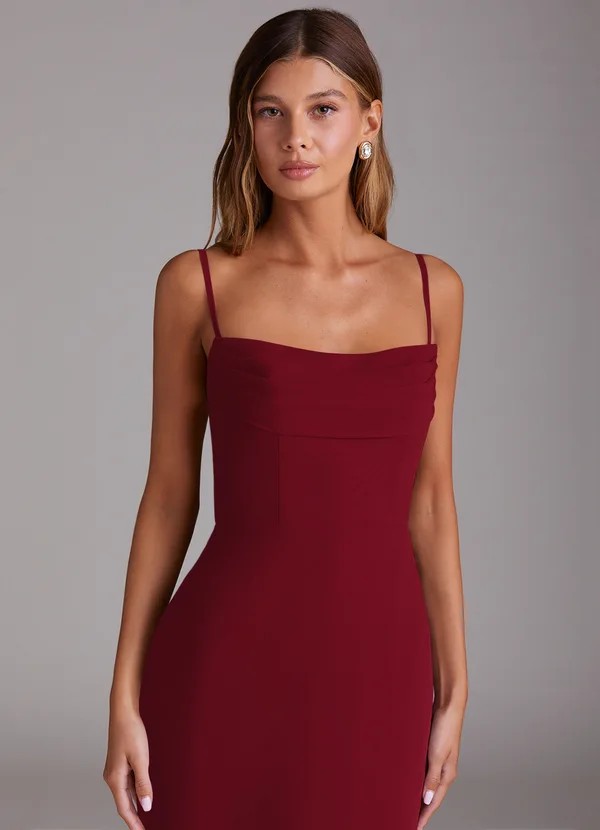How Long Before the Wedding Should I Order Bridesmaid Dresses?

Timing is one of the most important parts of planning bridesmaid attire. Choosing dresses too late can lead to stress, limited options, or costly rush fees, while ordering too early can create fit issues if measurements change.
So, how far in advance is just right? Let’s walk through the ideal timeline, why it matters, and how to plan fittings, color coordination, and delivery with zero surprises. Order bridesmaid dresses at least 4–6 months before the wedding.
This allows time for made-to-order production, shipping, and at least two rounds of fittings. If your bridal party is scattered or the dresses are custom-sized, aim for closer to 6–8 months in advance.
Alterations typically take 2–4 weeks, and last-minute changes should be finalized one month before the big day. Early planning ensures cohesive colors, stress-free fittings, and perfect photos.
Quick Planning
| Stage | Recommended Timeframe Before Wedding | What Happens | Why It Matters |
| Research & Color Decisions | 8–9 months | Choose palette, fabric, and vendor | Gives time to match décor and bridesmaid preferences |
| Measurements & Orders | 6–7 months | Take accurate body measurements and place orders | Ensures availability of styles and fabrics |
| Delivery & First Fitting | 3–4 months | Dresses arrive, try-on session | Allows time to spot issues early |
| Alterations | 2–3 months | Adjust hem, straps, or fit | Avoids rush alterations and stress |
| Final Fitting & Steam | 2–4 weeks | Confirm perfect fit, final press | Ensures everyone’s dress is photo-ready |
Why the Timeline Matters

Weddings involve coordination — across schedules, body types, and sometimes countries.
Each stage of ordering has its purpose: design choice, sizing, production, shipping, and alteration.
If any part runs late, the next step compresses — often resulting in unnecessary stress or extra cost.
Here’s why early ordering pays off:
- Custom or made-to-order dresses need time. Each gown is sewn after order confirmation.
- Alterations are rarely optional. Most bridesmaids need at least minor adjustments.
- Color consistency matters. Fabric dye lots can shift between production runs.
- Shipping or customs delays happen. Planning cushions those risks.
- Group coordination takes time. Especially when bridesmaids live in different cities or countries.
Ideal Bridesmaid Dress Timeline
Months Before the Wedding: Start Research
- Decide on your wedding theme, palette, and venue vibe.
- Explore online galleries or visit boutiques together (virtual try-ons help for distant parties).
- Narrow down silhouettes and fabrics that suit the season — chiffon for summer, velvet or crepe for winter.
- Order color swatches to confirm shades under different lighting.
- Confirm the brand or designer early to lock in availability.
Tip: If you’re planning a destination or holiday wedding, start even earlier — up to 10 months ahead.
Months Before: Take Measurements and Place Orders
- Schedule a group measurement day.
- Each bridesmaid should measure bust, waist, hips, and hollow-to-floor while wearing similar undergarments to wedding day.
- Double-check size charts on your chosen retailer’s site — don’t assume standard sizing fits all.
- Place all orders together to ensure consistent fabric dye lots.
- Confirm estimated production and delivery timelines with the vendor.
Pro Tip: Ordering as one group ensures dresses ship together and match perfectly in color and sheen.
Months Before: Confirm Shipping and Tracking
- Track updates once the order ships.
- Verify delivery addresses — especially if bridesmaids are in multiple locations.
- Upon arrival, each person should inspect their dress immediately for sizing accuracy and fabric condition.
- Store the dresses in breathable garment bags away from sunlight.
Tip: Never store chiffon or silk in plastic for extended periods — it can cause moisture build-up.
Months Before: Schedule First Fittings
- Plan an initial fitting session once all dresses have arrived.
- Focus on hemline, straps, waist fit, and overall silhouette.
- Pair with shoes and undergarments for accurate length and proportion.
- Take photos in natural light to ensure color uniformity across all bridesmaids.
Checklist for First Fitting
- Hem test with heels
- Check zipper or closure alignment
- Verify bust comfort while sitting and standing
- Mark potential alteration spots
Months Before: Begin Alterations
Most seamstresses recommend at least two fittings for accuracy.
This stage allows you to perfect every detail.
Alteration Steps
- First adjustment: trim length, tighten straps, smooth seams.
- Second adjustment: final fit check, walking comfort, and movement.
- Optional: add bra cups or small bust adjustments if needed.
Tip: Choose an experienced tailor familiar with bridesmaid or formalwear fabrics.
Some materials (like chiffon) require delicate handling.
Weeks Before: Final Fitting and Styling
- Try on the fully altered dress one last time.
- Confirm perfect fit in torso, hem, and neckline.
- Practice sitting, walking, and raising arms for movement ease.
- Steam or professionally press the dress and hang it in a cool, dry space.
Style Coordination:
- Confirm matching shoes or complementary tones.
- Align jewelry and bouquet colors for consistent photography.
Weeks Before: Final Checks
- Plan a “dress day” for the whole bridal party to inspect and photograph all dresses together.
- Bring lint rollers, steamer, garment bags, and shoe covers.
- Recheck color harmony under different lighting conditions — indoor vs outdoor.
- If any minor adjustments are needed, you still have time to fix them stress-free.
Tips for Bridesmaids Ordering Online
Online ordering is popular for its flexibility and broad style range.
To make the process smooth:
- Order early: Online made-to-order gowns require similar timelines as in-store dresses.
- Use exact measurements: Follow the brand’s measurement guide carefully.
- Group orders: Ensure all dresses are ordered together for color consistency.
- Delivery buffer: Allow 3–4 extra weeks for international shipping.
- Try on early: Never wait until the wedding month to open the package.
- Alter locally: Schedule a seamstress appointment right after delivery.
What Affects Delivery Time

Each brand has its own production and delivery schedule.
Key factors that influence your timeline include:
- Made-to-Order vs. Ready-to-Ship: Custom dresses take longer since they’re tailored after ordering.
- Seasonal Peaks: Spring and early summer weddings are busiest; production queues grow.
- Fabric Choice: Specialty fabrics may require additional lead time.
- Alteration Complexity: Detailed beading or lace overlays need precision adjustments.
- Shipping Distance: International bridesmaids or destination weddings add transit days.
Rule of Thumb: Always aim to have all dresses in-hand at least 3 months before the wedding date.
Signs You’re Ordering Too Late
If you find yourself within 2–3 months of the wedding and haven’t placed orders yet:
Potential Issues
- Limited fabric or color options.
- Restricted size availability.
- Extra rush or express fees.
- Tight alteration window (may cause fitting compromises).
- Increased stress and coordination pressure.
Solution:
If the timeline is short, look for ready-to-ship dresses or local boutiques offering in-stock styles.
Prioritize simple silhouettes (like A-line or sheath) that require minimal alterations.
How to Keep Everyone on Schedule
Managing multiple bridesmaids means setting clear deadlines and reminders.
Use a shared group chat or spreadsheet to track:
- Measurement completion dates
- Order confirmation numbers
- Shipping tracking links
- Fitting appointment dates
- Alteration updates
- Final delivery and steaming schedule
Helpful Tip: Assign one “dress captain” — usually the Maid of Honor — to help coordinate communication between the bride, bridesmaids, and tailor.
Common Mistakes to Avoid
- Procrastinating on color decisions: Waiting too long delays every step after.
- Skipping size charts: Different brands vary; don’t assume you know your dress size.
- Ordering separately: Mixing dye lots can cause slight shade mismatches.
- Ignoring alteration time: Every bridesmaid dress usually needs adjustments.
- Last-minute diet or fitness changes: Avoid major measurement changes after alterations begin.
Quick Reference Timeline Recap
| Task | Ideal Timing Before Wedding | Notes |
| Research styles & colors | 8–9 months | Collect swatches & decide palette |
| Take measurements | 6–7 months | Use proper measurement guide |
| Place group order | 6–7 months | Ensures matching dye lots |
| Receive dresses | 4–5 months | Inspect immediately |
| First fitting | 3–4 months | Plan seamstress visits |
| Alterations | 2–3 months | Allow for two sessions |
| Final fitting | 2–4 weeks | Steam, store, finalize look |
Seasonal Considerations

Spring Weddings
- High order volume—start at least 8 months out.
- Opt for breathable fabrics like chiffon or crepe.
Summer Weddings
- Plan fittings earlier to avoid heat-related swelling or size fluctuations.
- Lighter colors and quick-dry materials work best.
Fall Weddings
- Allow extra time for richer fabrics like satin or velvet.
- Perfect season for moody tones—test under evening lighting.
Winter Weddings
- Order early; holiday shipping can cause delays.
- Choose structured fabrics for indoor events.
Special Cases
Destination Weddings
- Add 1–2 months for customs clearance and longer shipping routes.
- Carry dresses in garment bags on the plane to avoid luggage mishaps.
Pregnant or Postpartum Bridesmaids
- Choose adjustable silhouettes like empire or wrap.
- Take measurements closer to the delivery date but order earlier for fabric consistency.
Plus-Size or Custom Fit
- Custom-made gowns require extended lead time for production.
- Schedule fittings early to ensure smooth adjustments.
Step Planning Checklist
Decide dress color and theme early.
Measure and place orders 6–7 months ahead.
Schedule group fittings 3–4 months prior.
Complete alterations by 1 month before.
Steam, store, and finalize accessories 2 weeks before.
Following this ensures a stress-free experience for both the bride and her bridesmaids.
Frequently Asked Questions
How early should I order bridesmaid dresses?
Plan to order 4–6 months before the wedding.
If dresses are made-to-order or customized, aim for 6–8 months to allow production and alterations.
What if bridesmaids live in different countries?
Coordinate color and fabric early. Each bridesmaid should measure locally but order from the same retailer to ensure consistency. Use shared delivery tracking to monitor all shipments.
How long do alterations take?
Minor adjustments take about 2–3 weeks, while complex tailoring (hems, bust, straps) may need 4 weeks. Always schedule fittings early to leave time for fine-tuning.
Can I order too early?
Yes, if you expect body changes or a long engagement. Ordering 10–12 months ahead may require later alterations for size changes. 6–8 months is the sweet spot.
What’s the fastest option if the wedding is soon?
Choose ready-to-ship or in-stock dresses. Simpler cuts like A-line, sheath, or wrap need fewer adjustments and can be altered quickly.
When should the final fitting happen?
2–3 weeks before the wedding ensures an accurate fit. Avoid last-minute weight or diet changes afterward.